Driving systems
Cruise control
Important safety notes
 WARNING
WARNING
The cruise control is a convenience system
designed to assist the driver during vehicle
operation. The driver is and must always
remain responsible for the vehicle's speed
and for safe brake operation.
Only use the cruise control if the road, traffic, and weather conditions make it advisable to travel at a constant speed.
- The use of the cruise control can be dangerous on winding roads or in heavy traffic because conditions do not allow safe driving at a constant speed.
- The use of the cruise control can be dangerous on slippery roads. Rapid changes in tire traction can result in wheel spin and loss of control.
- Deactivate the cruise control when driving in fog.
The "Resume" function should only be operated if the driver is fully aware of the previously set speed and wishes to resume this particular preset speed.
 WARNING
WARNING
The cruise control brakes automatically so
that the set speed is not exceeded.
General notes
Cruise control maintains a constant road speed for you. It brakes automatically in order to avoid exceeding the set speed. On long and steep downhill gradients, especially if the vehicle is laden or towing a trailer, you must select shift range 1, 2 or 3 in good time. By doing so, you will make use of the braking effect of the engine, which relieves the load on the brake system and prevents the brakes from overheating and wearing too quickly.
Use cruise control only if road and traffic conditions make it appropriate to maintain a steady speed for a prolonged period. You can set any road speed above 20 mph (30 km/h).

Cruise control should not be activated
during off-road driving.
Cruise control lever
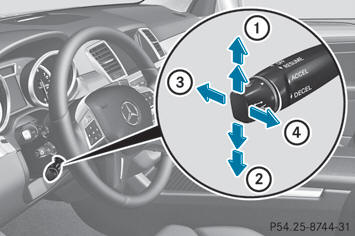
1 To activate or increase speed 2 To activate or reduce speed 3 To deactivate cruise control 4 To activate at the current speed/last stored speed
When you activate cruise control, the stored speed is shown in the multifunction display for five seconds. In the multifunction display, the segments between the stored speed and the maximum speed light up.
Activation conditions
To activate cruise control, all of the following activation conditions must be fulfilled: - your vehicle must not be secured by the electric parking brake.
- you are driving faster than 20 mph (30 km/h).
- ESP® must be active, but not intervening.
- the transmission must be in position D.
- DSR must be deactivated.
Activating cruise control
You can adopt the current speed if you are driving faster than 20 mph (30 km/h).
– Accelerate the vehicle to the desired speed.
– Briefly press the cruise control lever up 1 or down 2.
– Remove your foot from the accelerator pedal.
Cruise control is activated. The vehicle automatically maintains the stored speed.

Cruise control may be unable to maintain
the stored speed on uphill gradients. The
stored speed is resumed when the gradient
evens out. Cruise control maintains the
stored speed on downhill gradients by
automatically applying the brakes.
Activating with the current or last stored speed
 WARNING
WARNING
The set speed stored in memory should only
be set again if prevailing road conditions and
legal speed limits permit. Possible
acceleration or deceleration differences
arising from returning to the preset speed
could cause an accident and/or serious injury
to you and others.
– Briefly pull the cruise control lever towards you 4.
– Remove your foot from the accelerator pedal.
The first time cruise control is activated, it stores the current speed or regulates the speed of the vehicle to the previously stored speed.
Setting a speed
 WARNING
WARNING
Keep in mind that it may take a brief moment
until the vehicle has made the necessary
adjustments.
Increase or decrease the set vehicle speed to a value that the prevailing road conditions and legal speed limits permit. Otherwise, sudden and unexpected acceleration or deceleration of the vehicle could cause an accident and/or serious injury to you and others.
– Press the cruise control lever up 1 for a higher speed or down 2 for a lower speed.
– Keep the cruise control lever pressed until the desired speed is reached.
– Release the cruise control lever.
The new speed is stored.
– Making adjustments in 1 mph increments (1 km/h increments): briefly press the cruise control lever to the pressure point.
The last stored speed is increased or decreased in 1 mph increments (1 km/h increments).
– Making adjustments in 5 mph increments (10 km/h increments): briefly press the cruise control lever beyond the pressure point.
The last stored speed is increased or decreased in 5 mph increments (10 km/h increments).

Cruise control is not deactivated if you
depress the accelerator pedal. For
example, if you accelerate briefly to
overtake, cruise control adjusts the
vehicle's speed to the last speed stored
after you have finished overtaking.
Deactivating cruise control
There are several ways to deactivate cruise control:
– Briefly press the cruise control lever forwards 3.
or
– Brake.
Cruise control is automatically deactivated if: - you engage the electric parking brake.
- you are driving below 20 mph (30 km/h).
- ESP® intervenes or you deactivate ESP®.
- you activate DSR.
- you shift the transmission to position N while driving.
If cruise control is deactivated, you will hear a warning tone. You will see the Cruise Control Off message in the multifunction display for approximately five seconds.

When you switch off the engine, the last
speed stored is cleared.
DISTRONIC PLUS
Important safety notes
 WARNING
WARNING
The DISTRONIC PLUS requires familiarity with
its operational characteristics. We strongly
recommend that you review the following
information carefully before operating the
system.
 WARNING
WARNING
The DISTRONIC PLUS is a convenience
system. Its speed adjustment reduction
capability is intended to make cruise control
more effective and usable when traffic speeds
vary. It is not however, intended to, nor does
it, replace the need for extreme care.
The responsibility for the vehicle's speed, distance to the preceding vehicle and, most importantly, brake operation to ensure a safe stopping distance, always remains with the driver.
The DISTRONIC PLUS cannot take street and traffic conditions into account.
Complex driving situations are not always fully recognized by the DISTRONIC PLUS. This could result in wrong or missing distance warnings.
 WARNING
WARNING
The DISTRONIC PLUS adaptive cruise control
is not a substitute for active driving
involvement. It does not react to pedestrians
or on stationary objects, nor does it recognize
or predict the curvature and lane layout or the
movement of preceding vehicles. The
DISTRONIC PLUS can only apply a maximum
of 40% of the vehicle's braking power.
The DISTRONIC PLUS may not detect narrow vehicles possibly driving in front of you, such as motorcycles and vehicles driving in an offset formation.
It is the driver's responsibility at all times to be attentive to the road, weather and traffic conditions. Additionally, the driver must provide the steering, braking and other driving inputs necessary to remain in control of the vehicle.
High-frequency sources such as toll stations, speed measuring systems etc. can cause the DISTRONIC PLUS system to temporarily cease functioning.
 WARNING
WARNING
The DISTRONIC PLUS cannot take road and
traffic conditions into account. Only use the
DISTRONIC PLUS if the road, weather and
traffic conditions make it advisable to travel
at a constant speed.
 WARNING
WARNING
Use of the DISTRONIC PLUS can be
dangerous on slippery roads. Rapid changes
in tire traction can result in wheel spin and
loss of control.
The DISTRONIC PLUS does not function in adverse sight and distance conditions. Do not use the DISTRONIC PLUS during conditions of fog, heavy rain, snow or sleet.
 WARNING
WARNING
The DISTRONIC PLUS cannot take weather
conditions into account. Switch off the
DISTRONIC PLUS or do not switch it on if:
- roads are slippery or covered with snow or
ice. The wheels could lose traction while
braking or accelerating, and the vehicle
could skid.
- the DISTRONIC PLUS system sensor covers are dirty or visibility is diminished due to snow, rain or fog, for example. The distance control system functionality could be impaired.
Always pay attention to surrounding traffic conditions even while the DISTRONIC PLUS is switched on. Otherwise, you may not be able to recognize dangerous situations until it is too late. This could cause an accident in which you and/or others could be injured.
 WARNING
WARNING
The "Resume" function should only be
operated if the driver is fully aware of the
previously set speed and wishes to resume
this particular preset speed.
 WARNING
WARNING
Your undivided attention to street and traffic
conditions is necessary at all times whether
DISTRONIC PLUS is active or not.
The use of DISTRONIC PLUS can be dangerous on winding roads or in heavy traffic because conditions do not allow safe driving at a constant speed.
DISTRONIC PLUS does not react to stationary objects on the road (for example, a vehicle stopped in traffic or an abandoned vehicle).
DISTRONIC PLUS likewise does not react to oncoming vehicles.
Deactivate DISTRONIC PLUS:
- when changing to the right lane, if the
vehicles in the left lane are driving slower
- when driving into a filter lane or an
expressway exit
- in complex driving situations, for example
in construction sites on an expressway
In these situations DISTRONIC PLUS will
maintain the set speed if it is not deactivated.
DISTRONIC PLUS is intended only for maintaining a set speed and a set distance from the objects moving in front of the vehicle.
 WARNING
WARNING
An intermittent warning sounds and the
distance warning lamp  in the
in the
instrument
cluster is illuminated if the DISTRONIC PLUS
system calculates that the distance to the
vehicle ahead and your vehicle's current
speed indicate that the DISTRONIC PLUS will
not be capable of slowing the vehicle
sufficiently to maintain the preset following
distance, which creates a danger of a
collision.
Immediately brake the vehicle to increase your distance to the preceding vehicle. The warning sound is intended as a final caution in which you should intercede with your own braking inputs to avoid a potentially dangerous situation. Do not wait for the operation of the warning signal to intercede with your own braking. This will result in potentially dangerous emergency braking which will not always result in an impact being avoided.
Tailgating increases the risk of an accident.
 WARNING
WARNING
DISTRONIC PLUS brakes your vehicle with a
maximum deceleration of 13 ft/s2(4 m/s2).
This is equivalent to approximately 40 % of your vehicle's maximum possible deceleration.
You need to brake yourself to prevent a collision. DISTRONIC PLUS brakes the vehicle to restore the set distance from the vehicle ahead or the set speed.
 WARNING
WARNING
If you do not receive visual or acoustic
warning signals during a critical traffic
situation, DISTRONIC PLUS has either not
recognized the collision risk, has been
deactivated or is malfunctioning.
Remember, whether or not DISTRONIC PLUS is operating, it is ultimately always the drivers responsibility to apply the brakes in order to control the vehicle and avoid a collision.
 WARNING
WARNING
The vehicle can be braked when DISTRONIC
PLUS is activated. For this reason, deactivate
DISTRONIC PLUS if the vehicle is to be set in
motion by other means (e.g. in a car wash or
by towing).
If you want DISTRONIC PLUS to assist you, the radar sensor system must be activated and operational.
General notes
DISTRONIC PLUS regulates the speed and automatically helps you maintain the distance to the vehicle detected in front. It brakes automatically in order to avoid exceeding the set speed.
On long and steep downhill gradients, especially if the vehicle is laden or towing a trailer, you must select shift range 1, 2 or 3 in good time. By doing so, you will make use of the braking effect of the engine, which relieves the load on the brake system and prevents the brakes from overheating and wearing too quickly.
If a slower-moving vehicle is detected in front, DISTRONIC PLUS causes your vehicle to brake and maintain the preset distance to the vehicle in front.
If there is no vehicle driving in front of you, DISTRONIC PLUS functions like cruise control at a speed range between 20 mph (Canada: 30 km/h) and 120 mph (Canada: 200 km/h). If a vehicle is driving in front of you, it functions at a speed range between 0 mph (0 km/h) and 120 mph (Canada: 200 km/h).
Do not use DISTRONIC PLUS while driving on roads with steep gradients.
As DISTRONIC PLUS transmits radar waves, it can resemble the radar detectors of the responsible authorities. You can refer to the applicable section in the Operator's Manual if there are any questions concerning this.

USA only:
This device has been approved by the FCC
as a “Vehicular Radar System”. The radar
sensor is intended for use in an automotive
radar system only. Removal, tampering, or
altering of the device will void any
warranties, and is not permitted by the
FCC. Do not tamper with, alter, or use in
any non-approved way.
Any unauthorized modification to this device could void the user’s authority to operate the equipment.

Canada only: This device complies with
RSS-210 of Industry Canada. Operation is
subject to the following two conditions:
1. This device may not cause interference,
and
2. this device must accept any interference
received, including interference that may
cause undesired operation of the device.
Removal, tampering, or altering of the device will void any warranties, and is not permitted. Do not tamper with, alter, or use in any non-approved way.
Any unauthorized modification to this device could void the user’s authority to operate the equipment.
Cruise control lever
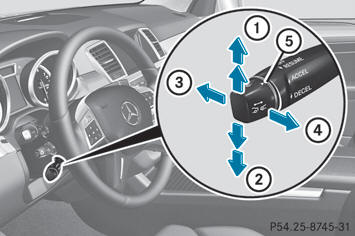
1 To activate or increase speed 2 To activate or reduce speed 3 To deactivate DISTRONIC PLUS 4 To activate at the current speed/last stored speed 5 To set the specified minimum distance
Activating DISTRONIC PLUS
Activation conditions
In order to activate DISTRONIC PLUS, the following conditions must be fulfilled: - the engine must be started. It may take up to two minutes after pulling away before DISTRONIC PLUS is operational.
- the electric parking brake must be released.
- ESP® must be active, but not intervening.
- the transmission must be in position D.
- the driver's door must be closed when you shift from P to D or your seat belt must be fastened.
- the front-passenger door and rear doors must be closed.
- DSR must be deactivated.
- the vehicle must not skid.
Activating while driving
When driving at speeds below 20 mph (30 km/h), you can only activate DISTRONIC PLUS if the vehicle in front has been detected and is shown in the multifunction display. If the vehicle in front is no longer detected and displayed, DISTRONIC PLUS switches off and a tone sounds.
– Briefly pull the cruise control lever towards you 4, or briefly press up 1 or down 2.
DISTRONIC PLUS is selected.
– Keep the cruise control lever pressed up 1 or down 2 until the desired speed is set.
– Remove your foot from the accelerator pedal.
Your vehicle adapts its speed to that of the vehicle in front, but only up to the desired stored speed.

If you do not fully release the accelerator
pedal, the DISTRONIC PLUS Passive
message appears in the multifunction
display. The set distance to a slowermoving
vehicle in front will then not be
maintained. You will be driving at the speed
you determine by the position of the
accelerator pedal.
Activating when driving towards a stationary vehicle
If the vehicle in front of you is stationary, you can only activate DISTRONIC PLUS once your vehicle is stationary as well.
- Briefly pull the cruise control lever towards you 4, or briefly press up 1 or down 2.
DISTRONIC PLUS is selected.

DISTRONIC PLUS can only be activated at
under 20 mph (30 km/h) if a vehicle in front
has been detected. Therefore, the
DISTRONIC PLUS distance display in the
instrument cluster should be activated.
- Keep the cruise control lever pressed up 1 or down 2 until the desired speed is set.

You can use the cruise control lever to set
the stored speed and the control on the
cruise control lever to set the specified
minimum distance.
Activating at the current speed/last stored speed
 WARNING
WARNING
The set speed stored in memory should only
be set again if prevailing road conditions and
legal speed limits permit. Possible
acceleration or deceleration differences
arising from returning to the preset speed
could cause an accident and/or serious injury
to you and others.
– Briefly pull the cruise control lever towards you 4.
– Remove your foot from the accelerator pedal.
DISTRONIC PLUS is activated. The first time it is activated, the current speed is stored. Otherwise, it sets the vehicle cruise speed to the previously stored value.
Display when DISTRONIC PLUS is activated
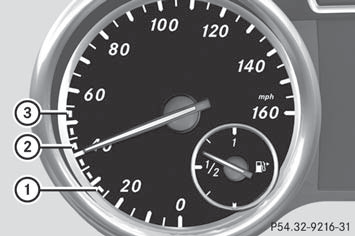
DISTRONIC PLUS displays in the speedometer
When DISTRONIC PLUS is activated, one or two segments 2 in the set speed range light up.

For design reasons, the speed displayed
in the speedometer may differ slightly from
the speed set for DISTRONIC PLUS.
If DISTRONIC PLUS detects a vehicle in front, segments 2 between speed of the vehicle in front 1 and stored speed 3 light up.
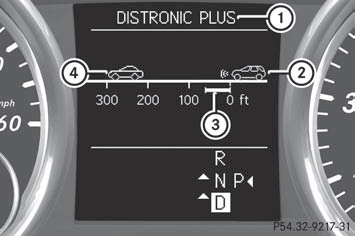
Distance display with DISTRONIC PLUS activated
in the multifunction display
1 DISTRONIC PLUS activated
2 Own vehicle
3 Specified minimum distance to the vehicle in front; adjustable
4 Vehicle in front, if detected
You can select the distance display in the Assistance menu of the onboard computer.
- Select the Distance Display function using the on-board computer.

You will see the stored speed for about
five seconds when you activate DISTRONIC
PLUS.
Driving with DISTRONIC PLUS
Pulling away
– If the vehicle in front pulls away: remove your foot from the brake pedal.
– Briefly pull the cruise control lever towards you.
or
– Accelerate briefly.
Your vehicle pulls away and adapts its speed to that of the vehicle in front.
Driving
 WARNING
WARNING
If you depress the brake, DISTRONIC PLUS is
deactivated unless your vehicle is stationary.
DISTRONIC PLUS then no longer brakes your vehicle. In such cases, control the distance from vehicles travelling in front with the brake alone. You could otherwise cause an accident and thereby injure yourself and others. The driver remains fully responsible for the vehicle's distance from other vehicles, the speed being driven and for braking in good time.
If there is no vehicle in front, DISTRONIC PLUS operates in the same way as cruise control.
If DISTRONIC PLUS detects that the vehicle in front has slowed down, it brakes your vehicle. In this way, the distance you have selected is maintained.
If DISTRONIC PLUS detects that the vehicle in front has increased speed, it increases your driving speed, but only up to the speed you have stored.
Changing lanes
If you wish to change to the passing lane (in
countries with right-hand traffic, the passing
lane is the left-hand lane), DISTRONIC PLUS
supports you if:
- you are driving faster than 40 mph
(60 km/h).
- DISTRONIC PLUS is maintaining the distance to a vehicle in front.
- you switch on the appropriate turn signals.
- DISTRONIC PLUS does not detect a danger of collision.
If these conditions are met, your vehicle is accelerated. Acceleration will be interrupted if changing lanes takes too long or if the distance between your vehicle and the vehicle in front becomes too small.
 WARNING
WARNING
DISTRONIC PLUS and Active Blind Spot Assist
are only aids designed to assist driving.
They do not relieve you of the responsibility of paying attention. The driver remains fully responsible for the vehicle's distance from other vehicles, the vehicle's speed and for braking in good time. Always pay attention to traffic conditions and your surroundings.
Otherwise, you may fail to recognize dangers in time, cause an accident and injure yourself and others.
Vehicles with COMAND

The following function is not operational
in all countries.
DISTRONIC PLUS uses additional information from your navigation system so that it can react appropriately to certain traffic situations. This is the case if, while following a vehicle, DISTRONIC PLUS is active and you: - approach or drive through a traffic circle - approach a T intersection - turn off at a freeway exit
Even if the vehicle in front leaves the detection range, DISTRONIC PLUS temporarily maintains the current driving speed and does not accelerate. This is based on the current map data in the navigation system.
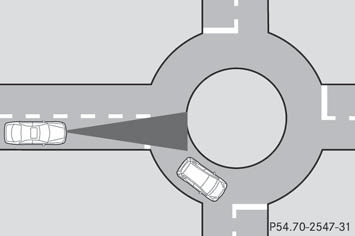
Example: traffic circle
The current speed is maintained:
- approximately 10 seconds before the
traffic circle/T intersection and for
approximately 1.5 seconds when driving on
the traffic circle
- approximately 12 seconds before reaching
a freeway exit and approximately
4 seconds after the freeway exit
Afterwards, the vehicle accelerates back to the set speed you specified.
Stopping
 WARNING
WARNING
Never get out of the vehicle when DISTRONIC
PLUS is activated.
DISTRONIC PLUS must also never be operated, activated or deactivated by a passenger or from outside the vehicle.
DISTRONIC PLUS does not replace the electric parking brake and must not be used for parking.
The DISTRONIC PLUS braking effect is canceled and the vehicle can start moving if: - DISTRONIC PLUS is deactivated using the cruise control lever.
- you accelerate.
- there is a malfunction in the system or an interruption in the power supply, e.g. battery failure.
- the electrical system in the engine compartment, the battery or the fuses are tampered with.
- the battery is disconnected.
If you wish to leave the vehicle or park it, deactivate DISTRONIC PLUS and secure the vehicle against rolling away.
If DISTRONIC PLUS detects that the vehicle in front is stopping, it brakes your vehicle until it is stationary.
Once your vehicle is stationary, it remains stationary and you do not need to depress the brake.

After a time, the electric parking brake
secures the vehicle and relieves the service
brake.

Depending on the specified minimum
distance, your vehicle will come to a
standstill at a sufficient distance behind the
vehicle in front. The specified minimum
distance is set using the control on the
cruise control lever.
The electric parking brake automatically
secures the vehicle if DISTRONIC PLUS is
activated and:
- the driver's door is open and the driver's seat belt is unfastened.
- the engine is switched off.
- a system malfunction occurs.
- the power supply is not sufficient.
On steep uphill or downhill inclines or if there is a malfunction, the transmission may also automatically be shifted into position P.
Setting a speed
 WARNING
WARNING
Keep in mind that it may take a brief moment
until the vehicle has made the necessary
adjustments.
Increase or decrease the set vehicle speed to a value that the prevailing road conditions and legal speed limits permit. Otherwise, sudden and unexpected acceleration or deceleration of the vehicle could cause an accident and/or serious injury to you and others.
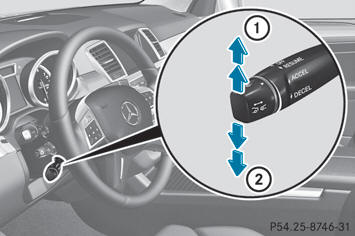
– Press the cruise control lever up 2 for a higher speed or down 3 for a lower speed.
– Keep the cruise control lever pressed until the desired speed is reached.
– Release the cruise control lever.
The new speed is stored. DISTRONIC PLUS is activated and adjusts the vehicle's speed to the new speed stored.
– Making adjustments in 1 mph increments (1 km/h increments): briefly press the cruise control lever to the pressure point.
The last stored speed increases or decreases in 1 mph increments (in Canada:
1 km/h increments).
– Making adjustments in 5 mph increments (10 km/h increments): briefly press the cruise control lever beyond the pressure point.
The last stored speed increases or decreases in 5 mph increments (10 km/h increments).
Setting the specified minimum distance
 WARNING
WARNING
It is up to the driver to exercise discretion to
select the appropriate setting given road
conditions, traffic, driver's preferred driving
style and applicable laws and driving
recommendations for safe following distance.
You can set the specified minimum distance for DISTRONIC PLUS by varying the time span between one and two seconds. With this function, you can set the minimum distance that DISTRONIC PLUS keeps to the vehicle in front, dependent on vehicle speed. You can see this distance in the multifunction display.
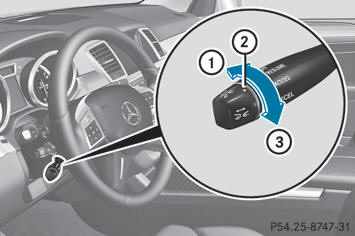
– To increase: turn control 2 in direction 3.
DISTRONIC PLUS then maintains a greater distance between your vehicle and the vehicle in front.
– To decrease: turn control 2 in direction 1.
DISTRONIC PLUS then maintains a shorter distance between your vehicle and the vehicle in front.

Make sure that you maintain a sufficiently
safe distance from the vehicle in front.
Adjust the distance to the vehicle in front if necessary.
Deactivating DISTRONIC PLUS
 WARNING
WARNING
The DISTRONIC PLUS switches off and
releases the brakes when the vehicle
decelerates below the minimum speed of
20 mph (30 km/h) by operation of the system
unless the DISTRONIC PLUS detects a vehicle
directly ahead of you. At that time the driver
must apply the brakes in order to reduce
vehicle speed further or bring it to a stop.
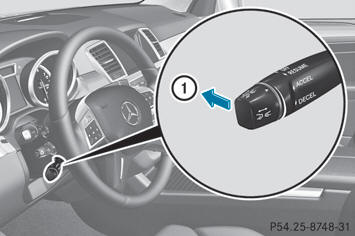
There are several ways to deactivate
DISTRONIC PLUS:
– Briefly press the cruise control lever
forwards 1.
or
– Brake, unless the vehicle is stationary.
When you deactivate DISTRONIC PLUS, the DISTRONIC PLUS Off message is shown in the multifunction display for approximately five seconds.

The last speed stored remains stored until
you switch off the engine.

DISTRONIC PLUS is not deactivated if you
depress the accelerator pedal. If you
accelerate to overtake, DISTRONIC PLUS
adjusts the vehicle's speed to the last
speed stored after you have finished
overtaking.
DISTRONIC PLUS is automatically
deactivated if:
- you engage the electric parking brake or if
the vehicle is automatically secured with
the electric parking brake
- you are driving slower than
15 mph (25 km/h) and there is no vehicle
in front, or if the vehicle in front is no longer
detected
- ESP® intervenes or you deactivate ESP®.
- the transmission is in the P, R or N position.
- you switch off the radar sensor system.
- you pull the cruise control lever towards you in order to pull away and the frontpassenger door or one of the rear doors is open.
- you activate DSR.
- the vehicle has skidded.
If DISTRONIC PLUS is deactivated, you will hear a warning tone. The DISTRONIC PLUS Off message is shown in the multifunction display for approximately five seconds.
You can select the distance display in the Assistance menu (Y page 232) of the onboard computer.
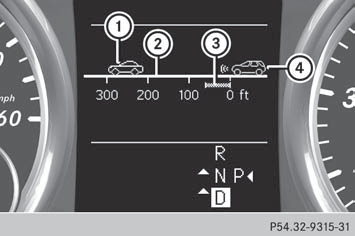
Distance display when DISTRONIC PLUS is
deactivated
1 Vehicle in front, if detected
2 Distance indicator, current distance to
the vehicle in front
3 Specified minimum distance to the
vehicle in front; adjustable
4 Own vehicle
– Select the Distance Display function using the on-board computer.
Tips for driving with DISTRONIC PLUS
Important safety notes
 WARNING
WARNING
The DISTRONIC PLUS works to maintain the
speed selected by the driver unless a moving
obstacle proceeding directly ahead of it in the
same travel direction is detected (e.g. following another vehicle ahead of you
at your
set distance).
This means that:
- Your vehicle can pass another vehicle after
you have changed lanes.
- While in a sharp turn or if the preceding vehicle is in a sharp turn, the DISTRONIC PLUS could lose sight of the preceding vehicle. Your vehicle could then accelerate to the previously selected speed.
The DISTRONIC PLUS regulates only the
distance between your vehicle and those
directly ahead of it. It may not register
stationary objects in the road, e.g.:
- a stopped vehicle in a traffic jam
- a disabled vehicle
- an oncoming vehicle
The driver must always be alert, observe all
traffic and intercede as required by means of
steering or braking the vehicle.
 WARNING
WARNING
The DISTRONIC PLUS should not be used in
snowy or icy road conditions.
The following contains descriptions of certain road and traffic conditions in which you must be particularly attentive. In such situations, brake if necessary. DISTRONIC PLUS is then deactivated.
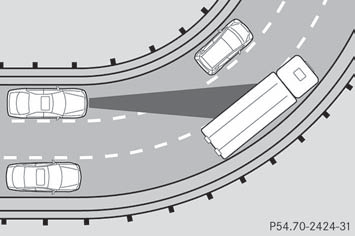
Cornering, going into and coming out of a
bend
The ability of DISTRONIC PLUS to detect vehicles when cornering is limited. Your vehicle may brake unexpectedly or late.
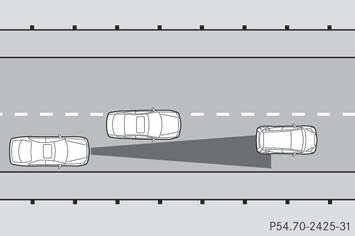
Vehicles traveling on a different line
DISTRONIC PLUS may not detect vehicles traveling on a different line. The distance to the vehicle in front will be too short.
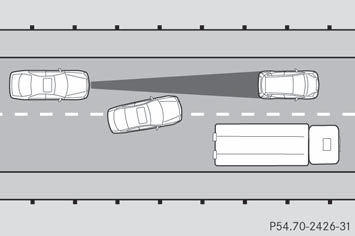
Other vehicles changing lanes
DISTRONIC PLUS has not detected the vehicle cutting in yet. The distance to this vehicle will be too short.
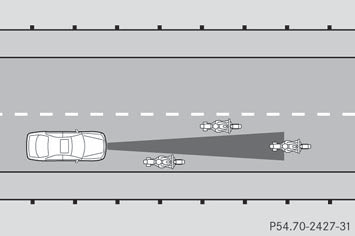
Narrow vehicles
DISTRONIC PLUS has not yet detected the vehicle in front on the edge of the road, because of its narrow width. The distance to the vehicle in front will be too short.
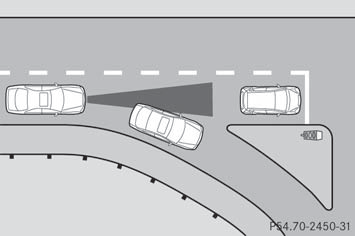
Obstructions and stationary vehicles
DISTRONIC PLUS does not brake for obstacles or stationary vehicles. If, for example, the detected vehicle turns a corner and reveals an obstacle or stationary vehicle, DISTRONIC PLUS will not brake for these.
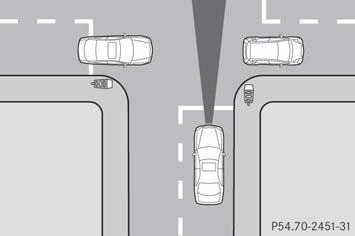
Crossing vehicles
DISTRONIC PLUS may mistakenly detect vehicles that are crossing your lane.
Activating DISTRONIC PLUS at traffic lights with crossing traffic, for example, could cause your vehicle to pull away unintentionally.
HOLD function
General notes
The HOLD function can assist the driver in the
following situations:
- when pulling away, especially on steep slopes
- when maneuvering on steep slopes
- when waiting in traffic
The vehicle is kept stationary without the driver having to depress the brake pedal.
The braking effect is canceled and the HOLD function deactivated when you depress the accelerator pedal to pull away.
Activation conditions
You can activate the HOLD function if: Rthe vehicle is stationary.
Rthe engine is running.
Rthe driver's door is closed or if your seat belt is fastened.
Rthe electric parking brake is released.
Rthe transmission is in position D, R or N.
RDISTRONIC PLUS is deactivated.
Activating the HOLD function
– Make sure that the activation conditions are met.
– Depress the brake pedal.
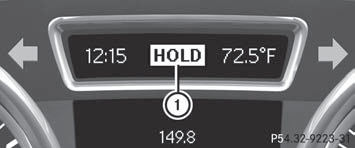
– Quickly depress the brake pedal further until HOLD display 1 appears in the multifunction display.
The HOLD function is activated. You can release the brake pedal.

If depressing the brake pedal the first
time does not activate the HOLD function,
wait briefly and then try again.
 WARNING
WARNING
The vehicle's brakes are applied when the
HOLD function is activated. For this reason,
deactivate the HOLD function if the vehicle is
to be set in motion by other means (e.g. in a
car wash or by towing).
Deactivating the HOLD function
The HOLD function is deactivated
automatically if:
- you accelerate and the transmission is in position D or R.
- the transmission is in position P.
- you apply the brakes again with a certain amount of pressure until HOLD disappears from the multifunction display.
- you secure the vehicle using the electric parking brake.
- you activate DISTRONIC PLUS.

After a time, the electric parking brake
secures the vehicle and relieves the service
brake.
 WARNING
WARNING
Never get out of the vehicle when the HOLD
function is activated.
The HOLD function must never be operated or deactivated by a passenger or from outside the vehicle.
The HOLD function does not replace the electric parking brake and must not be used for parking.
The braking effect of the HOLD function is canceled and the vehicle could roll away if: - the HOLD function is deactivated by depressing the accelerator pedal or the brake pedal.
- there is a malfunction in the system or an interruption in the power supply, e.g. battery failure.
- the electrical system in the engine compartment, the battery or the fuses are tampered with.
- the battery is disconnected.
The electric parking brake automatically
secures the vehicle if the HOLD function is
activated and:
- the driver's door is open and the driver's seat belt is unfastened.
- the engine is switched off.
- a system malfunction occurs.
- the power supply is not sufficient.
On steep uphill or downhill inclines or if there is a malfunction, the transmission may also automatically be shifted into position P.
AIRMATIC package
General notes
AIRMATIC enables a suspension tuning setting to be selected and regulates the damping behavior and level of your vehicle.
The system comprises a minimum of two components: ADS (Adaptive Damping System) (Y page 180) and level control (Y page 181). Your vehicle may also be equipped with the Active Curve System.
Observe the notes on driving with a trailer.
ADS (Adaptive Damping System)
General notes
ADS adapts the damping characteristics to the current operating and driving situation.
This depends on:
- your driving style
- the road surface conditions
- the ADS setting
- the vehicle level setting
Your selection remains stored even if you remove the SmartKey from the ignition lock.
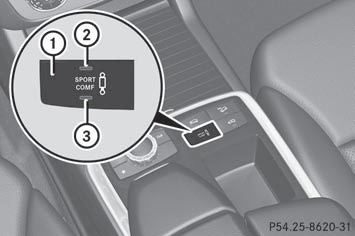
– Start the engine.
Sports tuning
The firmer suspension tuning in Sport mode ensures even better contact with the road.
Select this mode when employing a sporty driving style, e.g. on winding country roads.
– Press button 1.
Indicator lamp 2 lights up. Sports suspension tuning is selected. The vehicle is lowered by 0.6 in (15 mm).
Comfort tuning
In Comfort mode, the driving characteristics of your vehicle are more comfortable. Select this mode if you favor a more comfortable driving style, but also when driving fast on straight roads, e.g. freeways.
– Press button 1.
Indicator lamp 3 lights up. Comfort tuning is selected. The vehicle is raised by 0.6 in (15 mm).
Active Curve System
The Active Curve System uses active stabilizers to optimize both driving comfort and vehicle agility. Depending on the ADS mode selected (Y page 180), the Active Curve System also changes the setting.
If you select ADS comfort mode: - rolling movement is reduced in the event of changing surface undulations - the roll angle when cornering is reduced - the driving style is agile
If you select ADS sport mode: - the roll angle is reduced significantly - the driving style is even more agile
Level control
Important safety notes
Level control adapts the vehicle level automatically to the current operating and driving situation. This results in reduced fuel consumption and improved handling.
If you select ADS comfort mode (Y page 180), the vehicle is lowered to highspeed level as the speed increases. As the vehicle decelerates, the vehicle is raised back up to highway level.
If you select ADS sport mode (Y page 180), the vehicle skips highway level and lowers directly to high-speed level depending on the basic setting (Y page 182).
Make changes to the vehicle level while the vehicle is in motion. This enables the vehicle to adjust to the new level as quickly as possible.
The vehicle level may change visibly if you park the vehicle and the outside temperature changes. If the temperature drops, the vehicle level is lower; with an increase in temperature, the vehicle level rises.
If you unlock the vehicle or open a door, the vehicle begins to compensate for load discrepancies while still parked. However, for significant level changes, such as after the vehicle has been stationary for a long period, the engine must be on. For safety reasons, the vehicle is only lowered when the doors are closed. Lowering is interrupted if a door is opened, and it continues once the door has been closed.
 WARNING
WARNING
Make sure no one is near the wheel housing
or under the vehicle when you lower the
vehicle while it is standing still. Limbs could
become wedged into or under the vehicle.
For safety reasons, the vehicle can only be lowered with all doors and the tailgate closed.
Lowering is interrupted if a door or the tailgate is opened and will continue after the door is closed again.

When driving on extremely rough terrain,
select a high vehicle level in good time.
Make sure that there is always sufficient ground clearance to prevent damage to the vehicle.

Remove the key from the ignition before
raising one or more wheels with the
appropriate equipment.
For information about driving off-road.
Basic settings
The extent to which the vehicle is raised or lowered depends on the basic setting selected. Select raised level for off-road driving or highway/high-speed level for normal roads.
The individual vehicle levels differ from highway level as follows: - +/-0 in (+/-0 mm) at the highway level - –0.6 in (–15 mm) at the high-speed level - +2.3 in (+ 60 mm) at the raised level
Raised level
Only select raised level when this is appropriate for the road conditions.
Otherwise, fuel consumption may increase and handling may be affected.
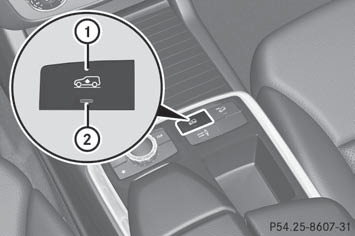
– Start the engine.
If indicator lamp 2 is not lit:
– Press button 1.
Indicator lamp 2 flashes. The vehicle rises to raised level.
While the adjustment is taking place, a message appears in the multifunction display, e.g.:
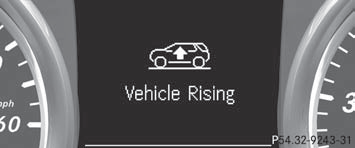
If you press the  or
or
 button on the
button on the
multifunction steering wheel, the message
will disappear.
Once the vehicle has reached raised level, indicator lamp 2 remains lit. The Vehicle Rising message disappears from the multifunction display.
If you attempt to select the raised level at a speed of over 40 mph (64 km/h), the Drive More Slowly message appears in the multifunction display.
Highway/high-speed level

Make sure that there is enough ground
clearance when the vehicle is being
lowered. It could otherwise hit the ground,
damaging the underbody.
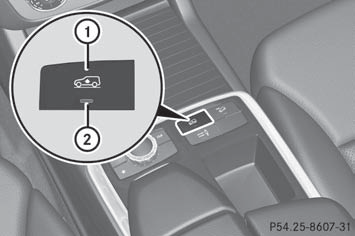
– Start the engine.
If indicator lamp 2 is lit:
– Press button 1.
Indicator lamp 2 flashes. The vehicle is adjusting to highway/high-speed level.
While the adjustment is taking place, a message appears in the multifunction display, e.g.:
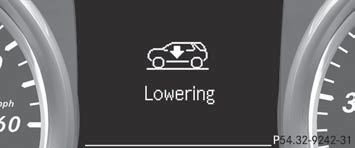
If you press the  or
or
 button on the
button on the
multifunction steering wheel, the message
will disappear.
Once highway level has been reached, indicator lamp 2 goes out. The Lowering message disappears from the multifunction display.
The vehicle automatically selects highway level if you are driving at a speed above 50 mph (80 km/h) or if you drive for approximately 20 seconds between 40 mph (64 km/h) and 50 mph (80 km/h). Depending on the ADS mode selected (Y page 180), the vehicle is lowered to high-speed level at higher speeds.
PARKTRONIC
Important safety notes
 WARNING
WARNING
The PARKTRONIC is a supplemental system.
It is not intended to, nor does it replace, the need for extreme care. The responsibility during parking and other critical maneuvers always remains with the driver.
 WARNING
WARNING
Make sure no persons or animals are in or
near the area in which you are parking/maneuvering. Otherwise, they could be
injured.
PARKTRONIC is an electronic parking aid with ultrasonic sensors. It indicates visually and audibly the distance between your vehicle and an object.
PARKTRONIC is activated automatically when
you:
- switch on the ignition
- shift the transmission to position D, R or N
- release the electric parking brake
PARKTRONIC is deactivated at speeds above 11 mph (18 km/h). It is reactivated at lower speeds.
PARKTRONIC monitors the area around your vehicle using six sensors in the front bumper and four sensors in the rear bumper.
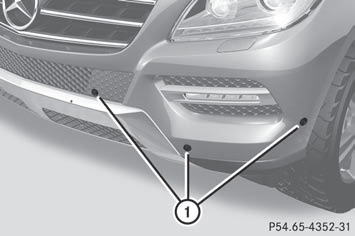
1 Sensors in the front bumper, left-hand side (example)
Range of the sensors
General notes
The sensors must be free of dirt, ice and slush; otherwise they may not function correctly. Clean the sensors regularly, taking care not to scratch or damage them.
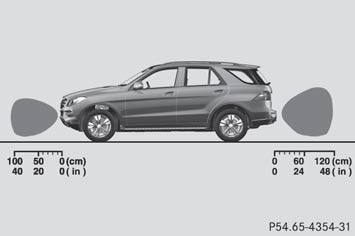
Side view
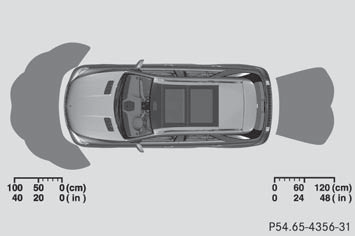
Top view
Front sensors

Rear sensors


When parking, pay particular attention to
objects above or below the sensors, such
as flower pots or trailer drawbars.
PARKTRONIC does not detect such objects when they are in the immediate vicinity of the vehicle. You could damage the vehicle or the objects.
The sensors may not detect snow and other objects that absorb ultrasonic waves.
Ultrasonic sources such as an automatic car wash, the compressed-air brakes on a truck or a pneumatic drill could cause PARKTRONIC to malfunction.
PARKTRONIC may not function correctly on uneven terrain.
Minimum distance

If there is an obstacle within this range, the relevant warning displays light up and a warning tone sounds. If the distance falls below the minimum, the distance may no longer be shown.
Warning displays
The warning displays show the distance between the sensors and the obstacle. The warning display for the front area is located on the dashboard above the center air vents.
The warning display for the rear area is in the roof lamp in the rear compartment.
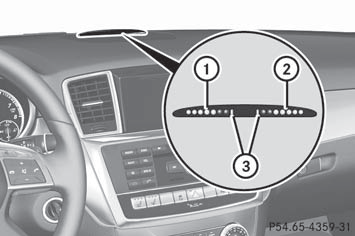
Warning display for the front area
1 Segments on the left-hand side of the
vehicle
2 Segments on the right-hand side of the
vehicle
3 Segments showing operational readiness
The warning display for each side of the vehicle is divided into five yellow and two red segments. PARKTRONIC is operational if yellow segments showing operational readiness 3 light up.
The selected transmission position and the direction in which the vehicle is rolling determine which warning display is active when the engine is running.
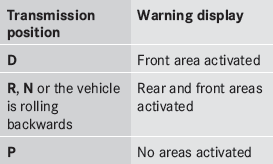
One or more segments light up as the vehicle approaches an obstacle, depending on the vehicle's distance from the obstacle.
From the:
- sixth segment onwards, you will hear an
intermittent warning tone for
approximately two seconds.
- seventh segment onwards, you will hear a warning tone for approximately two seconds. This indicates that you have now reached the minimum distance.
Deactivating/activating PARKTRONIC
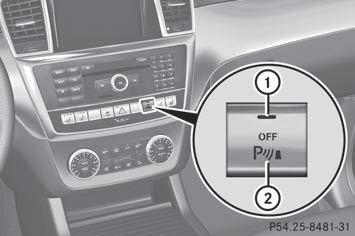
1 Indicator lamp
2 To deactivate/activate PARKTRONIC
If indicator lamp 1 lights up, PARKTRONIC is deactivated. Active Park Assist is then also deactivated.

PARKTRONIC is automatically activated
when you turn the SmartKey to position 2
in the ignition lock.
Trailer towing
PARKTRONIC is deactivated for the rear area when you establish an electrical connection between your vehicle and a trailer.

Fold in the ball coupling if the trailer tow
hitch is not required. PARKTRONIC
measures the minimum detection range to
an obstacle from the bumper, not the ball
coupling.
Problems with PARKTRONIC
| Problem | Possible causes/consequences and
 Solutions Solutions |
| Only the red segments in the PARKTRONIC warning displays are lit. You also hear a warning tone for approximately two seconds. PARKTRONIC is deactivated after approximately 20 seconds, and the indicator lamp in the PARKTRONIC button lights up. |
PARKTRONIC has malfunctioned and has switched off. – If problems persist, have PARKTRONIC checked at a qualified specialist workshop. |
| Only the red segments in the PARKTRONIC warning displays
are lit. PARKTRONIC is deactivated after approximately 20 seconds. |
The PARKTRONIC sensors are dirty or there is interference. – Clean the PARKTRONIC sensors. – Switch the ignition back on. |
| The problem may be caused by an external source of radio or
ultrasound waves. – See if PARKTRONIC functions in a different location. |
Active Parking Assist
Important safety notes
Active Parking Assist is an electronic parking aid with ultrasound. Ultrasound is used to measure the road on both sides of the vehicle.
A suitable parking space is indicated by the parking symbol. Active steering intervention can assist you during parking. You may also use PARKTRONIC (Y page 183). When PARKTRONIC is switched off, Active Parking Assist is also unavailable.
 WARNING
WARNING
Active Parking Assist is merely an aid and may
sometimes recommend parking spaces that
are not suitable for parking. For example,
these might be spaces where parking is
prohibited, driveways, unsuitable surfaces,
etc.
Active Parking Assist measures the parking space as you drive past it. Any later changes to the parking space are not taken into account. For instance, this may be the case when the vehicle parked in front of or behind the space changes its position or when an obstacle is moved into the parking space.
Active Parking Assist does not relieve you of the responsibility of paying attention. If you rely solely on Active Parking Assist, you could cause an accident and injure yourself and others.
You are always responsible for safety and must continue to pay attention to your immediate surroundings when parking and maneuvering.
 WARNING
WARNING
Objects located above the height range of
Active Parking Assist will not be detected
when the parking space is measured. These
are not taken into account when the parking
procedure is calculated, e.g. overhanging
loads, tail sections or loading ramps of goods
vehicles. In some circumstances, Active
Parking Assist may therefore guide you into
the parking space too early. This may lead to
a collision. For this reason, you should avoid
using Active Parking Assist in such situations.
 WARNING
WARNING
The front of the vehicle will veer out in the
direction of the oncoming traffic during the
parking operation. In some cases, the vehicle
will also take you onto sections of the
oncoming lane during the parking procedure.
You are responsible for safety at all times and must pay attention to any road users approaching or passing. Stop the vehicle if necessary or cancel the Active Parking Assist parking procedure.
 WARNING
WARNING
Make sure no persons or animals are in or
near the area in which you are parking/maneuvering. Otherwise, they could be
injured.
Use Active Parking Assist for parking spaces: - that are parallel to the direction of travel - that are on straight roads, not bends - that are on the same level as the road, e.g. not on the pavement
Parking tips:
- on narrow roads, drive past the parking
space as close as possible.
- parking spaces that are littered, overgrown or partially occupied by trailer drawbars might be identified incorrectly or not at all.
- snowfall or heavy rain may lead to a parking space being measured inaccurately.
- pay attention to the PARKTRONIC (Y page 184) warning messages during the parking procedure.
- you can intervene in the steering procedure to correct it at any time. Active Parking Assist will then be canceled.
- when transporting a load which protrudes from your vehicle, you should not use Active Parking Assist.
- never use Active Parking Assist when snow chains or an emergency spare wheel are mounted.
- make sure that the tire pressures are always correct. This has a direct influence on the parking characteristics of the vehicle.
- the way your vehicle is positioned in the parking space after parking is dependent on various factors. These include the position and shape of the vehicles parked in front and behind it and the conditions of the location. In some cases, Active Parking Assist may guide you too far into a parking space, or not far enough into it. In some cases, it may also lead you across or onto the curb. If necessary, you should abort the parking procedure with Active Parking Assist.
- you can also engage forward gear prematurely. The vehicle redirects and does not drive as far into the parking space.
Should the gear change occur too soon to achieve a sensible parking position, the parking procedure will be aborted.

If unavoidable, you should drive over
obstacles such as curbs slowly and not at
a sharp angle. Otherwise, you may damage
the wheels or tires.
Detecting a parking space
Active Parking Assist is switched on
automatically when driving forwards. The
system is operational at speeds of up to
approximately 22 mph (35 km/h). While in
operation, the system independently locates
and measures parking spaces on both sides
of the vehicle. When driving at speeds below
19 mph (30 km/h), you will see the parking
symbol as a status indicator in the instrument
cluster. By default, Active Parking Assist only
displays parking spaces on the frontpassenger
side. Parking spaces on the
driver's side are displayed as soon as the turn
signal on the driver's side is activated. If you
wish to park in a space on the driver's side,
the indicator on the driver's side must remain
on. This must remain switched on until you
acknowledge the use of Active Parking Assist
by pressing the  button on the
button on the
multifunction steering wheel.
When a parking space has been detected, an arrow towards the right or the left also appears.
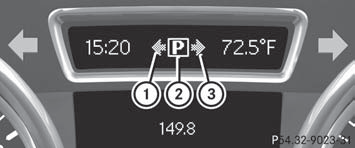
1 Detected parking space on the left
2 Parking symbol
3 Detected parking space on the right
Active Parking Assist will only detect parking
spaces:
- that are parallel to the direction of travel
- at least 59 in (1.5 m) wide
- at least 51 in (1.3 m) longer than your vehicle
A parking space will be displayed to you as you drive by until you are approximately 50 ft (15 m) away from it.
Parking
 WARNING
WARNING
PARKTRONIC and Active Parking Assist are
merely parking aids and may not detect all
obstacles. They do not relieve you of the
responsibility of paying attention.
You are always responsible for safety and must continue to pay attention to your immediate surroundings when parking and maneuvering. You could otherwise endanger yourself and others.
– Stop the vehicle when the parking space symbol shows the desired parking space in the instrument cluster.
– Shift the transmission to position R.
The Start Park Assist? Yes: OK No: 
message appears in the multifunction
display.
– To cancel the procedure: press the
 button on the multifunction
button on the multifunction
steering
wheel or pull away.
or
– To park using Active Parking Assist: press the
 button on the multifunction
button on the multifunction
steering wheel.
The Park Assist Active Accelerate and Brake Observe Surroundings message appears in the multifunction display.
 WARNING
WARNING
When parking, you need to make sure that no
obstacles are located in the vicinity of the
vehicle during the entire operation. Active
Parking Assist does not relieve you of the
responsibility of paying attention. It merely
aids you by intervening actively in the
steering.
To stop the vehicle or to avoid an accident, you need to apply the brakes yourself.
– Let go of the multifunction steering wheel.
– Back up the vehicle, being ready to brake at all times. Do not exceed a speed of app
See also:
Problems with the SmartKey
...
Driving tips
Kickdown
Use kickdown for maximum acceleration:
■ Depress the accelerator pedal beyond the
pressure point.
The transmission shifts to a lower gear
depending on the engine speed.
■ ...
Vehicle data
Please note that for the specified vehicle
data:
- the heights specified may vary as a result
of:
- tires
- load
- condition of the suspension
- optional equipment
...
